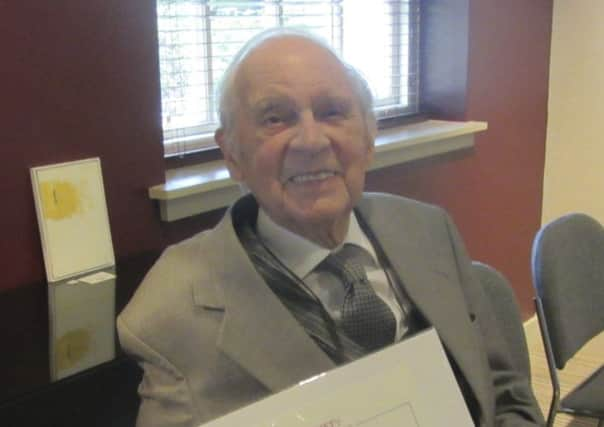Obituary: Sir Anthony Wheeler, architect


Sir Anthony Wheeler was a distinguished Scottish architect and an eminent past president of the Royal Scottish Academy. His career led him from an early posting as Assistant City Architect in Oxford in the 1950s to a leading firm of London architects before returning to Scotland to take up the post of chief assistant to the Glenrothes Development Corporation.
A few years later Wheeler established his private practice, H Anthony Wheeler, with an office first at Sailor’s Wharf, Kirkcaldy and later also in Edinburgh. It was to prove a most successful and forward- looking practice.
Advertisement
Hide AdAdvertisement
Hide AdBecause his practice was centred in Kirkcaldy, Wheeler was involved in the restoration and preservation of many of the charming and historic villages in the kingdom of Fife. Particularly noteworthy was the work he carried out in 1962 on The Gyles in Pittenweem.
Harry Anthony Wheeler was educated at Stranraer High School and studied at the Glasgow School of Architecture in the late 1930s while apprenticed to two eminent Glasgow firms. He was awarded a travelling scholarship in 1939 to further his studies in France. Throughout the war Wheeler served with the Royal Artillery and saw action in France, Holland, Belgium and Germany. He was demobbed as a captain.
In 1946 he undertook a study tour in Italy under the Glasgow School of Art’s (GSA) John Keppie Travelling Scholarship, and in September he returned to continue his studies at the GSA.
Wheeler was a talented student and won both the Bellahouston Travelling Scholarship and the RIBA’s Grissell Gold Medal. He qualified in 1948. After his years in the south Wheeler was appointed senior lecturer at Dundee School of Architecture in 1952 and founded his architectural practice in Kirkcaldy.
In 1954 Frank Sproson was made a partner in what became the respected and well known practice of Wheeler & Sproson.
The firm was active in the imaginative early restorations under the National Trust’s enlightened Little Houses Scheme. Wheeler & Sproson won many awards from the Saltire Society in the 1960s and 70s for their work on historic houses. Wheeler was also a pioneer in many modern buildings around Scotland – some of which caused some controversy.
His designs included the student union building in St Mary’s Place, St Andrews – an advanced modern concrete structure which is undergoing extensive rebuilding.
In the early 1980s Wheeler designed a modern three-storey family house in Edinburgh’s Dean Village at Hawthornbank Lane. It was in this building that Wheeler lived for many years.
Advertisement
Hide AdAdvertisement
Hide AdA major design achievement was Wheeler’s inspired design for St Columba’s Parish Church, Glenrothes.
With its imposing tower the kirk was built in 1960 and designed in conjunction with the theologians at St Mary’s College of St Andrews University with the emphasis on how the Scottish Reformation could be best expressed in a church building.
In the work connected with the National Trust, Wheeler played a key role in the conversion of part of Falkland Palace into a private apartment for Major Crichton Stuart, the Bannockburn Heritage Centre and the conversion in West Lothian of the former Houston House into Macdonald Houston Hotel – whose original style Wheeler subtly preserved by maintaining its fine baronial white exterior.
Included amongst the many other commissions throughout Scotland were the Hunter Building of Edinburgh College of Art, the married naval quarters at Rosyth, Faslane and Elgin, staff housing at Aberdeen Royal Infirmary and Ninewells Hospital and the Medical School and, most appropriately, the Tourist Centre at Stranraer.
Wheeler was a talented draughtsman and artist all his life – until recently he remained an active exhibiting artist with the Scottish Society of Architect Artists.
Wheeler served as president of the Royal Scottish Academy (1983–90) and was most active in incorporating Associate Members of the Academy to full Membership.
He was also keen to promote the academy to a wider public and wrote: “The Friends of the RSA and the RSA Shop were both developed under my presidency and were highly successful.” On completion of his term as president Wheeler’s portrait was painted – resplendent in bowtie and chain of office – by Alberto Morrocco.
Wheeler had a deep involvment in many important Scottish institutions. He served on the Royal Fine Art Commission for Scotland, was president of the Royal Incorporation of Architects in Scotland and received an honorary doctorate from Robert Gordon University.
Advertisement
Hide AdAdvertisement
Hide AdIn August last year, Wheeler was made an honorary fellow of the Scottish Society of Architect Artists at a ceremony at the House for an Art Lover, Glasgow. The citation was presented by The Duke of Gloucester.
Apart from his painting and sketching, Wheeler remained a keen angler and lover of music and theatre. He was devoted to the Scottish countryside.
Wheeler married Dorothy Campbell in 1944. She predeceased him and he is survived by their daughter.
ALASDAIR STEVEN